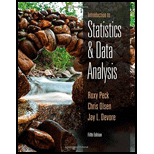
Concept explainers
The article “Acupuncture for Bad Backs: Even Sham Therapy Works” (Time, May 12, 2009) summarized a study conducted by researchers in Seattle. In this study, 638 adults with back pain were randomly assigned to one of four groups. People in group 1 received the usual care for back pain. People in group 2 received acupuncture at a set of points tailored specifically for each individual. People in group 3 received acupuncture at a standard set of points typically used in the treatment of back pain. Those in group 4 received fake acupuncture—they were poked with a toothpick at the same set of points chosen for the people in group 3!
Two conclusions from the study were:
(1) patients receiving real or fake acupuncture experienced a greater reduction in pain than those receiving usual care; and (2) there was no significant difference in pain reduction for those who received acupuncture and those who received fake acupuncture toothpick pokes.
- a. Is this study an observational study or an experiment? Explain.
- b. Is it reasonable to conclude that receiving either real or fake acupuncture was the cause of the observed reduction in pain in those groups compared to the usual care group? What aspect of this study supports your answer? (Hint: Look at Table 2.1.)
Trending nowThis is a popular solution!

Chapter 2 Solutions
Introduction to Statistics and Data Analysis
 Glencoe Algebra 1, Student Edition, 9780079039897...AlgebraISBN:9780079039897Author:CarterPublisher:McGraw Hill
Glencoe Algebra 1, Student Edition, 9780079039897...AlgebraISBN:9780079039897Author:CarterPublisher:McGraw Hill Holt Mcdougal Larson Pre-algebra: Student Edition...AlgebraISBN:9780547587776Author:HOLT MCDOUGALPublisher:HOLT MCDOUGAL
Holt Mcdougal Larson Pre-algebra: Student Edition...AlgebraISBN:9780547587776Author:HOLT MCDOUGALPublisher:HOLT MCDOUGAL College Algebra (MindTap Course List)AlgebraISBN:9781305652231Author:R. David Gustafson, Jeff HughesPublisher:Cengage Learning
College Algebra (MindTap Course List)AlgebraISBN:9781305652231Author:R. David Gustafson, Jeff HughesPublisher:Cengage Learning Big Ideas Math A Bridge To Success Algebra 1: Stu...AlgebraISBN:9781680331141Author:HOUGHTON MIFFLIN HARCOURTPublisher:Houghton Mifflin Harcourt
Big Ideas Math A Bridge To Success Algebra 1: Stu...AlgebraISBN:9781680331141Author:HOUGHTON MIFFLIN HARCOURTPublisher:Houghton Mifflin Harcourt




